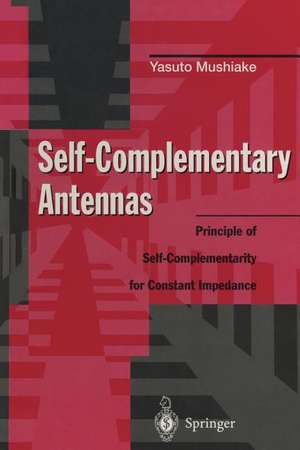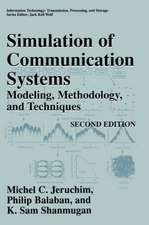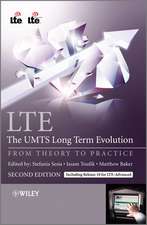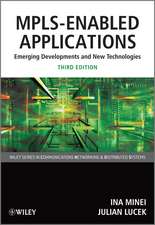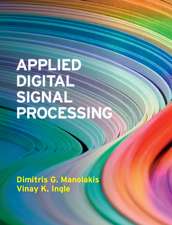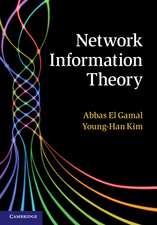Self-Complementary Antennas: Principle of Self-Complementarity for Constant Impedance
Autor Yasuto Mushiakeen Limba Engleză Paperback – 16 sep 2011
Preț: 720.04 lei
Preț vechi: 878.09 lei
-18% Nou
Puncte Express: 1080
Preț estimativ în valută:
137.78€ • 144.15$ • 114.45£
137.78€ • 144.15$ • 114.45£
Carte tipărită la comandă
Livrare economică 03-17 aprilie
Preluare comenzi: 021 569.72.76
Specificații
ISBN-13: 9781447112556
ISBN-10: 1447112555
Pagini: 148
Ilustrații: XIII, 128 p.
Dimensiuni: 152 x 229 x 8 mm
Greutate: 0.23 kg
Ediția:Softcover reprint of the original 1st ed. 1996
Editura: SPRINGER LONDON
Colecția Springer
Locul publicării:London, United Kingdom
ISBN-10: 1447112555
Pagini: 148
Ilustrații: XIII, 128 p.
Dimensiuni: 152 x 229 x 8 mm
Greutate: 0.23 kg
Ediția:Softcover reprint of the original 1st ed. 1996
Editura: SPRINGER LONDON
Colecția Springer
Locul publicării:London, United Kingdom
Public țintă
ResearchCuprins
1 Introduction.- 1.1 Self-complementary and related broad-band antennas.- 1.2 Background to the emergence of the self-complementary antenna.- 1.3 Brief history of self-complementary antennas.- 2 Fundamental Theories of Complementary Structures.- 2.1 A pair of mutually dual structures.- 2.2 Symmetrical and anti-symmetrical electromagnetic fields.- 2.3 Electromagnetic fields for complementary planar structures.- 3 Impedance Relationships for Complementary Planar Structures.- 3.1 Input impedances of mutually complementary two-terminal planar structures.- 3.2 Input impedances of mutually complementary multi-element planar structures.- 3.3 Examples of complementary planar structures.- 4 Origination of Self-Complementary Planar Structures and Discovery of their Constant-Impedance Property.- 4.1 Origination of self-complementary planar structures.- 4.2 Constant-impedance property of self-complementary planar structures.- 4.3 Examples of self-complementary planar structures.- 5 Multi-Terminal Self-Complementary Planar Structures.- 5.1 Rotationally symmetric multi-terminal self-complementary planar structures.- 5.2 Single-phase excitations for rotationally symmetric multi-terminal self-complementary planar structures.- 5.3 Axially symmetric multi-terminal self-complementary planar structures.- 5.4 Axially symmetric two-port self-complementary planar structures.- 5.5 Coupling-less property between loaded unipole-notch type self-complementary planar structures.- 6 Three-Dimensional Self-Complementary Structures.- 6.1 A pair of dual structures consisting of crossed infinite planar sheets of compound perfect conductors.- 6.2 Three-dimensional complementary structures.- 6.3 Three-dimensional self-complementary structures.- 6.4 Examples of three-dimensional self-complementary structures.- 7 Stacked Self-Complementary Antennas.- 7.1 Stacking of self-complementary antennas.- 7.2 Co-planar stacked self-complementary antennas.- 7.3 Some variations of co-planar stacked self-complementary structures.- 7.4 Side-by-side stacked self-complementary antennas.- 7.5 Compound-stacked self-complementary antennas.- 8 General Considerations about Approximations and Modifications of Self-Complementary Antennas.- 8.1 Approximations and modifications for practical purposes.- 8.2 Approximation by truncation.- 8.3 Approximation by replacement with conducting rods.- 8.4 Modification by deformation.- 8.5 Modification by partial excision.- 8.6 An example of transformation from a self-complementary sheet structure to the conducting rod structure.- 9 Developmental Studies of Rotationally Symmetric Self-Complementary Antennas.- 9.1 Alternate-leaves type self-complementary antenna.- 9.2 Approximation and modification of alternate-leaves type self-complementary antennas.- 9.3 Modified four-terminal self-complementary antenna on conical surface.- 9.4 Non-constant-impedance property of incorrectly arranged log-periodic structures.- 9.5 Other developmental studies for derivatives of rotationally symmetric self-complementary structures.- 10 Developmental Studies of Axially Symmetric Self-Complementary Antennas.- 10.1 Experimental study of equally spaced unipole-notch array antenna.- 10.2 Equally spaced unipole-notch array antenna on a conical ground plane for the circularly polarized wave.- 10.3 Unipole-notch alternate array antennas stacked on both edges of an angular conducting sheet.- 10.4 Unipole-notch array antennas formed on the substrate of a printed circuit.- 11 Monopole-Slot Type Modified Self-Complementary Antennas.- 11.1 Monopole-slot type antennas derived from the three-dimensional self-complementary antenna.- 11.2 A monopole-slot antenna element as a limiting case.- 12 Conclusion.- References.- Author Index.
